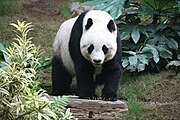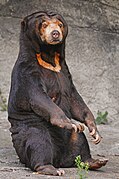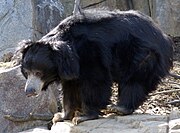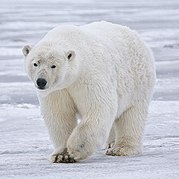List of ursids

The eight species of Ursidae are split into five
Conventions
| Critically Endangered (0 species) | |
| EN | Endangered (0 species) |
|---|---|
| VU | Vulnerable (6 species) |
| NT | Near threatened (0 species) |
| LC | Least concern (2 species) |
Conservation status codes listed follow the
Classification
The family Ursidae consists of eight extant species belonging to five genera in three subfamilies and divided into dozens of extant subspecies. This does not include ursid hybrid species such as grizzly–polar bear hybrids or extinct prehistoric species.
- Subfamily Ailuropodinae
- Genus Ailuropoda (panda bears): one species
- Subfamily Tremarctinae
- Genus Tremarctos (short-faced bears): one species
- Subfamily Ursinae
- Genus Helarctos: (sun bear): one species
- Genus Melursus: (sloth bear): one species
- Genus Ursus(bears): four species
- Genus
|
Ursids
The following classification is based on the taxonomy described by Mammal Species of the World (2005), with augmentation by generally accepted proposals made since using molecular phylogenetic analysis; this includes the division of the giant panda into two subspecies. There are several additional proposals which are disputed, such as reclassifying the subspecies of the brown bear into a smaller set of clades,[2][3] which are not included here.
Subfamily Ailuropodinae
| Common name | Scientific name and subspecies | Range | Size and ecology | IUCN status and estimated population |
|---|---|---|---|---|
| Giant panda | A. melanoleuca (David, 1869) Two subspecies
|
Central China
|
Size: 150–180 cm (59–71 in) long, plus 10–15 cm (4–6 in) tail 80–123 kg (176–271 lb)[4][5] Habitat: Forest[6] Diet: Eats only bamboo[6] |
VU
|
Subfamily Tremarctinae
| Common name | Scientific name and subspecies | Range | Size and ecology | IUCN status and estimated population |
|---|---|---|---|---|
| Spectacled bear | T. ornatus (F. Cuvier, 1825) |
Andes mountains in South America
|
Size: 120–200 cm (47–79 in) long, plus 7 cm (3 in) tail 60–175 kg (132–386 lb)[7] Habitat: Shrubland, grassland, and forest[8] Diet: Primarily eats bromeliads and palm trees, as well as cattle, other mammals, and fruit[8] |
VU
|
Subfamily Ursinae
| Common name | Scientific name and subspecies | Range | Size and ecology | IUCN status and estimated population |
|---|---|---|---|---|
| Sun bear | H. malayanus (Raffles, 1821) Two subspecies
|
Southeast Asia (current range in brown, former in black)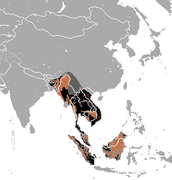
|
Size: 120–150 cm (47–59 in) long, plus 3–7 cm (1–3 in) tail 35–80 kg (77–176 lb)[9][10] Habitat: Forest and shrubland[11] Diet: Primarily eats termites, ants, beetle larvae, bee larvae, honey, and fruit[11] |
VU |
| Common name | Scientific name and subspecies | Range | Size and ecology | IUCN status and estimated population |
|---|---|---|---|---|
| Sloth bear | M. ursinus (Shaw, 1791) Two subspecies
|
India (current range in green, former in black)
|
Size: 150–180 cm (59–71 in) long, plus 7–12 cm (3–5 in) tail 54–141 kg (119–311 lb)[13] Habitat: Shrubland, grassland, forest, and savanna[14] Diet: Primarily eats termites and fruit[14] |
VU |
| Common name | Scientific name and subspecies | Range | Size and ecology | IUCN status and estimated population |
|---|---|---|---|---|
| American black bear | U. americanus Pallas, 1780 Sixteen subspecies
|
North America (current range in red, former in pink)
|
Size: 120–200 cm (47–79 in) long, plus 8–14 cm (3–6 in) tail 39–409 kg (86–902 lb)[16] Habitat: Forest, inland wetlands, grassland, shrubland, and desert[17] Diet: Omnivorous; eats vegetation, roots, buds, fruit, nuts, insects, fish, mammals, and carrion[17] |
LC |
| Asian black bear | U. thibetanus Cuvier, 1823 Seven subspecies
|
South and East Asia (current range in brown, former in black)
|
Size: 120–180 cm (47–71 in) long, plus 6–11 cm (2–4 in) tail 65–150 kg (143–331 lb)[19] Habitat: Forest, inland wetlands, grassland, and shrubland[20] Diet: Eats vegetation, insects, fruit, nuts, ungulates, and livestock[20] |
VU |
| Brown bear | U. arctos Linnaeus, 1758 Sixteen subspecies
|
Northern North America and Europe, and northern and central Asia
|
Size: 100–280 cm (39–110 in) long, plus 6–20 cm (2–8 in) tail 80–550 kg (176–1,213 lb)[21] Habitat: Desert, forest, inland wetlands, grassland, and shrubland[22] Diet: Omnivorous; eats grasses, herbs, roots, berries, nuts, insects, mammals, and fish[22] |
LC
|
| Polar bear | U. maritimus Mulgrave, 1774 |
Polar North America and Asia
|
Size: 220–244 cm (87–96 in) long, plus 7–13 cm (3–5 in) tail 408–726 kg (900–1,600 lb)[23] Habitat: Marine oceanic, shrubland, forest, grassland, marine coastal/supratidal, and marine intertidal[24] Diet: Primarily eats seals, as well as walruses, beluga whales, birds, fish, vegetation and kelp[24] |
VU |
Prehistoric ursids
In addition to extant bears, a number of prehistoric species have been discovered and classified as a part of Ursidae. In addition to being placed within the three extant subfamilies, they have been categorized within the extinct subfamilies
- Subfamily Agriotheriinae†
- Genus Agriotherium†
- A. africanum (3.6–2.5 Mya)
- A. gregoryi
- A. inexpetans (12–5.3 Mya)
- A. insigne
- A. schneideri (14–2.5 Mya)
- A. sivalensis (5.4–3.6 Mya)
- Genus Agriotherium†
- Subfamily Ailuropodinae
- Tribe Ailuropodini
- Genus Agriarctos†
- Genus Ailurarctos†
- A. lufengensis[27]
- Genus Ailuropoda
- A. baconi (2.6–0.012 Mya)
- A. fovealis
- A. microta (2.6–0.78 Mya)
- A. wulingshanensis (2.6–0.78 Mya)
- Genus Kretzoiarctos† (12–8.7 Mya)
- K. beatrix(12–8.7 Mya)
- Tribe Indarctini†
- Tribe
- Subfamily Hemicyoninae†
- Tribe Cephalogalini†
- Genus Adelpharctos† (34–23 Mya)
- A. ginsburgi (29–23 Mya)
- A. mirus (34–28 Mya)
- Genus Cephalogale†
- C. geoffroyi
- C. meschethense (29–23 Mya)
- C. minor (34–28 Mya)
- Genus Cyonarctos† (29–23 Mya)
- C. dessei (29–23 Mya)
- Genus Filholictis†
- F. filholi
- Genus Phoberogale†
- P. depereti
- P. shareri (31–20 Mya)
- Genus Adelpharctos† (34–23 Mya)
- Tribe Hemicyonini†
- Genus Dinocyon†
- D. aurelianensis
- D. sansaniensis
- D. thenardi (17–15 Mya)
- Genus Hemicyon†
- H. barbouri (14–10 Mya)
- H. goriachensis
- H. grivensis
- H. minor
- H. sansaniensis (16–12 Mya)
- H. statzlingii
- Genus Zaragocyon† (23–20 Mya)
- Z. daamsi (23–20 Mya)
- Genus Dinocyon†
- Tribe Phoberocyonini†
- Genus Phoberocyon†
- P. aurelianensis (21–7.2 Mya)
- P. huerzeleri
- P. johnhenryi (21–15 Mya)
- Genus Plithocyon† (16–11 Mya)
- P. armagnacensis (16–11 Mya)
- P. barstowensis (16–13 Mya)
- P. ursinus (16–13 Mya)
- Genus Phoberocyon†
- Tribe Cephalogalini†
- Subfamily Tremarctinae
- Genus Arctodus (short-faced bear)† (2.2–0.012 Mya)
- A. pristinus (lesser short-faced bear) (2.2–0.3 Mya)
- A. simus (giant short-faced bear) (1.1–0.012 Mya)
- Genus Arctotherium†
- A. angustidens (1.2–0.7 Mya)
- A. bonariense (0.6–0.037 Mya)
- A. tarijense (0.5–0.010 Mya)
- A. vetustum (0.7–0.3 Mya)
- A. wingei (0.1–0.012 Mya)
- Genus Plionarctos† (10.3–1.8 Mya)
- P. edensis (10.3–4.9 Mya)
- P. harroldorum (4.9–1.8 Mya)
- Genus Tremarctos (1.8 Mya–present)
- T. floridanus (Florida spectacled bear) (1.8–0.012 Mya)
- Genus Arctodus (short-faced bear)† (2.2–0.012 Mya)
- Subfamily Ursavinae†
- Subfamily Ursinae
- Genus Aurorarctos† (15–12.5 Mya)
- A. tirawa (15–12.5 Mya)
- Genus Protarctos† (4.9–3.6 Mya)
- P. abstrusus (4.9–3.6 Mya)
- Genus Ursus
- U. arctos priscus (steppe brown bear)[a][28]
- U. arvernensis (3.2–2.5 Mya)
- U. deningeri (0.79–0.12 Mya) (Deninger's bear)[29]
- U. dolinensis (Gran Dolina bear)[30]
- U. dentrificius (2.6–0.12 Mya)
- U. etruscus (Etruscan bear)[31]
- U. eogroenlandicus
- U. ingressus (Gamssulzen cave bear)[32]
- U. inopinatus
- U. jenaensis
- U. labradorensis
- U. malayanus (0.13–0.012 Mya)
- U. maritimus tyrannus (tyrant polar bear)[a][33]
- U. minimus (Auvergne bear) (4.2–2.5 Mya)
- U. optimus
- U. praemalayanus
- U. priscus
- U. rossicus (pleistocene small cave bear)[34]
- U. spelaeus (cave bear) (2.6–0.012 Mya)
- U. spitzbergensis
- U. vitabilis
- Genus Aurorarctos† (15–12.5 Mya)
-
Restoration of Arctodus simus
-
Restoration of Arctotherium bonariense
-
Restoration of Ursus spelaeus (cave bear)
-
Prehistoric art of Ursus spelaeus (cave bear)
See also
Notes
References
- ISBN 978-0-253-02637-8.
- S2CID 23361337.
- PMID 29187630.
- ^ Bies, LeeAnn (2002). "Ailuropoda melanoleuca". Animal Diversity Web. University of Michigan. Retrieved March 24, 2020.
- ^ "Physical Description". Knowledge Hub. World Wide Fund for Nature. Retrieved March 24, 2020.
- ^ a b c Swaisgood, R.; Wang, D.; Wei, F. (2017) [errata version of 2016 assessment]. "Ailuropoda melanoleuca". IUCN Red List of Threatened Species. 2016: e.T712A121745669.
- ^ "Spectacled bear (Tremarctos ornatus)". ARKive. Wildscreen. Archived from the original on June 14, 2017. Retrieved March 25, 2020.
- ^ .
- ^ "Malayan sun bear (Helarctos malayanus)". ARKive. Wildscreen. Archived from the original on December 21, 2014. Retrieved March 26, 2020.
- ISBN 978-1-55821-474-3.
- ^ .
- ^ ISBN 978-1-134-19434-6.
- ^ "Sloth Bear". The Photo Ark. National Geographic. 12 March 2010. Retrieved March 24, 2020.
- ^ .
- S2CID 86410436.
- ^ Dewey, Tanya; Kronk, Christine (2007). "Ursus americanus". Animal Diversity Web. University of Michigan. Retrieved March 24, 2020.
- ^ .
- ^ "Black Bear Study Finds Growing Populations, But Combating Illegal Trade Remains a Challenge". WWF News and Reports. World Wide Fund for Nature. April 30, 2002. Retrieved February 29, 2020.
- ^ Goodness, Tracie (2004). "Ursus thibetanus". Animal Diversity Web. University of Michigan. Retrieved March 24, 2020.
- ^ .
- ^ "Brown Bear (Ursus arctos) Fact Sheet: Physical Characteristics". San Diego Zoo Global Library. San Diego Zoo. October 15, 2019. Retrieved March 26, 2020.
- ^ .
- ^ "Polar Bear". The Photo Ark. National Geographic. September 10, 2010. Retrieved March 24, 2020.
- ^ .
- S2CID 92716329.
- ^ "Fossilworks: Ursidae". Paleobiology Database. University of Wisconsin–Madison. Retrieved December 17, 2021.
- ^ Qiu, Z.; Qi, G. (1989). "Yúnnán lù fēng wǎn zhōng xīn shì de dà xióngmāo zǔxiān huàshí" 云南禄丰晚中新世的大熊猫祖先化石 [Ailuropod Found From the Late Miocene Deposits in Lufeng, Yunnan] (PDF). Vertebrata PalAsiatica. 27 (3): 153–169.
- ISSN 0213-4497.
- S2CID 83501403.
- .
- ^ Pérez-Hidalgo, T.; José, T. (1992). "The European descendants of Ursus etruscus C. Cuvier (Mammalia, Carnivora, Ursidae)". Boletín del Instituto Geológico y Minero de España. 103 (4): 632–642.
- ^ Rabeder, G.; Hofreiter, M.; Nagel, D.; Withalm, G. (January 2004). "New taxa of alpine cave bears (Ursidae, Carnivora)". Cahiers scientifiques-Muséum d'histoire naturelle de Lyon. 2 (2): 49–67.
- hdl:10138/37762.
- ISSN 0213-4497. Archived from the original(PDF) on 2021-03-08. Retrieved 2020-03-24.

